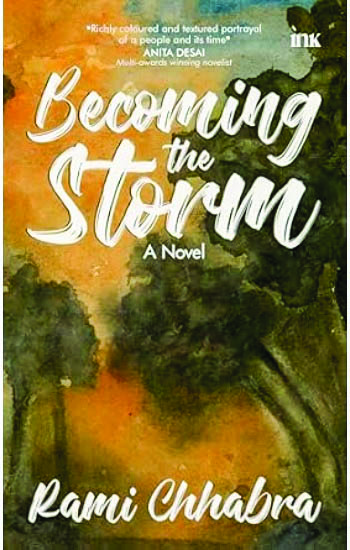A novel that brings you into the bosom of a post-Partition Punjabi family, Rami Chhabra’s “Becoming the Storm” evocatively recreates the Delhi of the 1960s, a time of sleepy bungalows and flowering gardens.
The family we meet is comfortably off but by no means wealthy, retired army folks who are trying to re-establish themselves in newly Independent India. There is a close knit extended family too, sisters and brothers, cousins and uncles bound by love and kinship but also divided by human greed and expectations.
It is an era of beginnings. A time when Janpath is still called the imperial Queensway but the Cottage Emporium has come up on it to celebrate India’s traditional crafts. A melding of the old and the new.
Ironically, for young people of the time, freedom is identified as modern and western, a walk away from the rigidity of Indian custom and caste. Caught between the old and the new are girls who aspire to education and careers but frequently succumb to family expectations of early marriages.
In the 1950s and 1960s New Delhi is growing. Houses are being built with hard earned savings as refugee families seek stability, careers are being established and matches made.
The heroine of our tale is a smart young college girl with a promising career ahead of her. Suddenly she meets an ‹England returned› gentrified young man who woos her into marriage. He seems so eligible and her family is desperate for their daughter to ‘settle down’.
There are last-minute demands from her in-laws for a big fat wedding but somehow her parents meet these demands, in hopes that their daughter›s future will be secure. Indu is just 18 and naive enough to believe that life will be all roses.
Disillusionment settles in as Indu realises that her marital family is so unlike her own. Her traditional, uneducated mother-in-law resents this dowryless modern bahu. In contrast is the younger bahu from a rich family who comes loaded with goodies.
The cruelty and greed of the custom of dowry is an underlying theme of the novel. Other patriarchal customs too are quietly questioned, such as the touching of the feet of the elders or rituals like ‘matha teko’ (where a bride touches her forehead to the ground at the feet of the father-in-law). There is an inherent critique of the pressure on girls to marry early.
Then there is the side story of the young separated woman who waits years to get a divorce until the Nehru government brings changes to the Hindu Marriage Act. Indu›s concern about her fate shows us how little social acceptance there was of women who were separated or single or widowed.
The portrayal of wives and mothers who unquestioningly obey their husbands, whether from love or regard or the observance of social norms, is also gently but not overtly critiqued.
Other social inequalities too do not escape the writer, such as the irony of a young domestic worker waiting on teenagers barely older than him. But these are asides. Let us return to the main story.
Tired of taunts about her shortcomings and finding that all her efforts at taking up responsibilities and appeasing her in-laws are fruitless, Indu persuades her reluctant husband to move out of his family›s home. Having an independent home suits her and soon she has children to happily bring up. She takes on various assignments to help balance the home budget. Yet the couple’s happiness is short lived as the relationship with the in-laws deteriorates.
Indu finally begins to assert herself and demand that her in-laws start treating her properly. This takes a toll on the marriage. Her husband, she feels, has never defended her, being caught in the tug-of-war between her and his parents. He, on the other hand, feels she should be a more traditional housewife. There are fights and recriminations.
As the marriage sours, a stage comes when Indu›s mother urges her to leave her husband and come home. Indu contemplates divorce but realises that she should not burden her widowed mother by walking out with two children in tow.
After a violent confrontation with her husband Indu considers taking her own life but, in a rather melodramatic finale to the tale, she eventually decides that life is worth living. There is more to do in the world beyond the family. The bond too can perhaps be repaired, the family saved. The open ended conclusion suggests hope and reconciliation.
Yet the novel also points to the alternative paths that Indian women have over the years traversed. After all, ‹azadi› is a slogan for both collective and individual personal struggle.
There is no preaching anywhere in the book, no allegory. The difficult marriage, the dominance of the male and his family, domestic violence, inequality in the family are all too familiar in India today. These are social problems that still raise their ugly heads today, particularly violence in the home and dowry demands, as police statistics point out. The big fat dowry and the big fat wedding, richly amplified on social media, has become the norm. Even the poorest emulate it, often selling a field or taking a loan and living indebted lifelong. Why has the dowry law become defunct in consumerist India? These are questions that need to be urgently raised.
In Indu’s story we simply see a woman who almost breaks down in the face of such oppression but then courageously stands up to assert her right to individuality and dignity, forging a path for younger women.
Women like Indu were zephyrs but by breaking social norms they can transform into storms!
Sujata Madhok is a veteran journalist who writes on development issues. She is currently President of the Delhi Union of Journalists.

